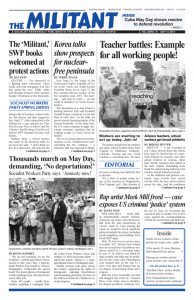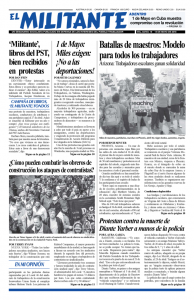Kim Jong Un, the leader of the Democratic People’s Republic of Korea in the North, met South Korean President Moon Jae-in April 27, the first summit between leaders of the two countries since 2007. The meeting — and more to come — are the result of initiatives by North Korea’s leaders.
The discussion is a step toward a meeting between Kim and President Donald Trump, tentatively set for late May or early June. On the table are moves toward denuclearization of the Korean Peninsula. At the same time, the U.S. rulers continue to apply draconian economic sanctions that hit working people in North Korea the hardest.
The two Korean leaders met at Panmunjom, in the “demilitarized zone” separating the two countries — a boundary that was imposed by Washington, with the complicity of Moscow, when they tore the country in half in 1945. Kim and Moon agreed to press Beijing and Washington to join in reaching a treaty finally declaring an end to the 1950-53 Korean War.
The U.S. imperialist rulers crushed a rebellion by workers and peasants in the southern part of the country in 1949 and imposed a pro-U.S. dictatorship there. They invaded the North, seeking to restore the rule of the capitalists and landlords. A popular uprising had swept the North and established a workers and farmers government. Some 4 million people were killed in the war.
The U.S. rulers failed to accomplish their goals. North Korean forces, aided by Chinese volunteers, pushed the invading army back to the 38th parallel. Since then, every U.S. administration has refused to sign a peace treaty.
Kim and Moon also agreed to re-establish reunion programs — suspended in 2015 — for Koreans with families living on different sides of the border. The South Korean government says 57,920 people living in the South have relatives in the North with no way to see them.
In their joint declaration both government heads repeated what they have said for decades — that they favor the denuclearization of the Korean Peninsula. The capitalist rulers in the South place their country under Washington’s “nuclear umbrella,” which deploys nuclear-armed submarines in nearby waters to defend U.S. imperialist interests. Washington also deploys 28,500 troops in South Korea and maintained nuclear weapons there through 1991.
For its part, the North Korean government’s decision to develop and test nuclear weapons, and its threats to destroy Seoul in a “sea of fire,” has weakened its capacity to win support from working people in South Korea, Japan and elsewhere against attacks by Washington.
After the summit, South Korean officials reported Kim said the North would abandon its nuclear weapons if Washington pledged not to invade. Secretary of State Mike Pompeo reiterated the U.S. rulers’ demand for an immediate, verifiable and “irreversible” end to North Korea’s nuclear weapons program April 29, while saying nothing about Washington’s massive nuclear arsenal.
An April 13 message by Steve Clark for the Socialist Workers Party to the DPRK welcomes the “recent steps that have opened the road to agreement by Seoul, Beijing and Washington to sit down at the table with the DPRK for talks.” The SWP demands the U.S. government “sign a peace treaty ending the murderous war the U.S. imperialist rulers inflicted on the Korean people” and get its “troops, ships, planes, and missile and radar systems out of Korea! For a Korean Peninsula, Japan and surrounding skies and waters free of nuclear weapons!”
Sanctions punish working people
The summit declaration made no mention of the impact on working people of years of sanctions imposed on North Korea by the U.S. rulers and their allies at the United Nations. The combination of tightening sanctions, and the Chinese rulers’ decision to step up their enforcement of these punitive measures, has increased the hardship working people in the DPRK confront, especially in rural areas. This includes factory and mine closures, and food, medicine and fuel shortages. The governments of the U.S., U.K., Australia and Canada, as well as Japan, are collaborating on monitoring any DPRK attempt to get around the restrictions.
Kim and Moon’s joint summit declaration urges “steps towards the connection and modernization of the railways and roads … between Seoul and Sinuiju,” a city that lies on North Korea’s border with China. Such infrastructure development across the peninsula would only be possible if there was an easing of sanctions imposed on the North.
On April 21 Kim announced that his government was shifting its strategy from simultaneously pursuing nuclear weapons and economic growth to concentrate solely on building the country’s economy.
The liberal press barons in the U.S. — whose lust to bring down President Trump determines all their “reporting” — had previously sought to paint the administration’s course towards North Korea as bellicose. Now they claim he is dangerously naive. Nicholas Eberstadt argues in the New York Times that the U.S. government is being duped by what he calls Pyongyang’s “phony peace ploy.” To bolster his claim, Eberstadt falsely portrays the North Korean government, not Washington, as the aggressor in the 1950-53 war.
Blinded by their furor against Trump — and the millions of workers who voted for him — these media moguls cannot accept that his administration is winning support as a peace president.
The lessening of military tensions in the region and an end to the sanctions would create better conditions for advancing the struggles of working people in the area. And advance efforts to reunify the country.

